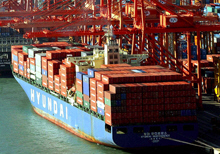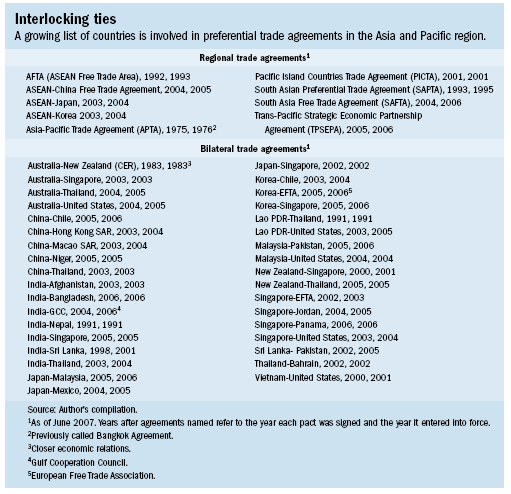
Typical street scene in Santa Ana, El Salvador. (Photo: iStock)
IMF Survey: 'Noodle Bowl' Risk of Trade Pact Overlap
June 25, 2007
- Regional trade agreements (RTAs) have spread in Asia, Pacific over past 20 years
- RTAs can be effective means to expand regional trade, cooperation
- Continued proliferation of RTAs risks overlapping, unmanageable trade pacts
Regional trade agreements (RTAs) have proliferated across the Asia and Pacific region over the past 20 years.

Container ship docked in Pusan, Korea—country with regional, bilateral trade agreements in Asia-Pacific (photo: Newsis/Reuters)
Asian trade agreements
As of May 2007, more than 40 RTAs had been signed among Asian countries themselves or between one or more of these countries and selected trading partners outside the region, and an additional 70 RTAs were under negotiation.
However, unlike in other regions, most RTAs in Asia have followed, rather than preceded, trade liberalization on a multilateral, most-favored-nation (MFN) basis. Regional trade integration has thus been only one facet of a much more broadly based process of international integration. Is the trend toward more regional trade pacts helpful, or does it hamper more broad-based multilateral trade liberalization?
Highlights
The issue: The continued proliferation of regional trade agreements (RTAs) risks turning the world trade system into a "noodle bowl" of overlapping and potentially inconsistent and unmanageable RTAs.
Bottom line: A recent IMF Working Paper (WP 07/53) that examined RTAs in Asia during 1984-2003 suggests that participation in an RTA does not, in general, seem to have occurred at the expense of trade with nonmembers.
Policy implications: The paper's findings reinforce the need for countries with more restrictive trade regimes to continue reducing high tariffs even if they are participating in regional arrangements.
An IMF study found that RTAs can be an effective means to expand regional trade and cooperation. However, the discriminatory aspects of RTAs can also be harmful if they are pursued not as a complement to, but as a substitute for, multilateral trade liberalization. In fact, RTAs can give rise to welfare losses for countries that are both members and nonmembers of the pact by diverting imports from low-cost nonmember sources to higher-cost member suppliers. In such cases, the cost difference borne by importing members is commonly known as a trade diversion effect.
If, on the other hand, resources previously devoted to high-cost domestic production are reallocated domestically to more efficient producers as a result of the RTA, economic welfare can increase—a process known as the trade creation effect. The risk of a net welfare loss is more likely to be minimized if the protection versus nonmembers is low to start with, or if the RTA partners agree to introduce swift reductions in their MFN tariffs over time, which ideally should eventually match their preferential rates. However, vested interests within RTA members can sometimes turn the agreements into closed blocs, discouraging multilateral trade liberalization and distorting the pattern of international trade.
Why so popular?
So why are countries eager to enter into an RTA? The upsurge in RTAs around the globe reflects both economic and noneconomic motivations. Regional trade integration can serve as a vehicle for dialogue and coordination on regional issues that are not part of the multilateral agenda. These might include regulatory harmonization, infrastructure development, and collaboration among members to facilitate transit trade and transport. And they can stimulate inward foreign direct investment and growth through technological transfers.
Their proliferation can also be motivated by a growing sense that regional agreements elsewhere put the left-out countries at a disadvantage. By entering first into a regional agreement, a country may increase its bargaining power in multilateral negotiations by having a common (regional) position on sensitive sectors (for example, textiles and agriculture) in which some developed countries still maintain a protectionist stance.
Moreover, some economists have argued that by entering into multilateral negotiations as a region rather than as a country, small states might face lower fixed costs of negotiation. Although liberalization on an MFN basis is generally agreed to be the best policy under most circumstances, the extent to which RTAs produce trade diversion or trade creation remains an empirical question.

Consequently, it is useful to ask whether the recent proliferation of preferential agreements in Asia has had welfareenhancing or welfare-reducing effects on trade among their memberships. To shed light on this question, the IMF study used a gravity model of trade—which predicts trade flows based on a country's economic size and distance from a trade partner—to estimate how membership in the Association of Southeast Asian Nations (ASEAN), the South Asian Preferential Trade Agreement (SAPTA), the Asia Pacific Economic Cooperation (APEC) forum, and the Australia-New Zealand Closer Economic Relations (ANZCER) agreement may have influenced the level and the direction of trade.
Early liberalization
The study's empirical estimates suggest that membership in these RTAs did promote trade among their members, but not at the expense of trade with nonmembers during 1984-2005. Such results appear to reflect Asian countries' strong inclination to pursue nondiscriminatory liberalization at an early phase in their development.
Indeed, most of these countries' integration with the global economy preceded regional integration, and members of Asian RTAs recorded more trade with the rest of the world than other countries with similar characteristics in other regions, with this effect being strongest for countries with the lowest MFN rates.
However, it is conceivable that a proliferation of RTAs that is not accompanied by unilateral and multilateral liberalization could lead to suboptimal trade patterns. To guard against this, countries whose MFN rates are higher than those in the rest of the region would be well advised to continue to pursue broad-based trade liberalization on an MFN basis in tandem with their regional integration.
Pan-Asian trade zone?
Asia's trade pacts currently link specific groups of regional countries (see table). But would a pan-Asian free trade area produce greater benefits? The study suggests that greater coherence among existing RTAs in terms of tariff preferences and rules of origin could help minimize the administrative costs associated with verifying that rules of origin have been observed and limit possible distortions in trade patterns. Rules of origin are established in free trade agreements to ensure that only goods originating in participating countries enjoy preferences.
Indeed, since late 2006, Japan has advocated the creation of a pan-Asian free trade area, which could include Australia, China, India, Japan, Korea, New Zealand, and the 10 ASEAN countries. Such a free trade area could potentially avoid some of the risks associated with proliferating RTAs. However, it is difficult to tell whether a consolidation of Asian RTAs into a single free trade area would address all the pitfalls of RTAs. An assessment of this question would require further analysis to estimate the possible implications for Asian intraregional trade and the region's trade with the rest of the world.







